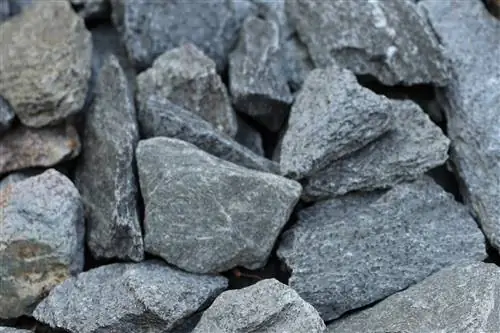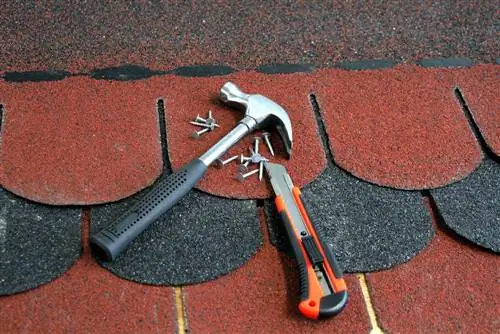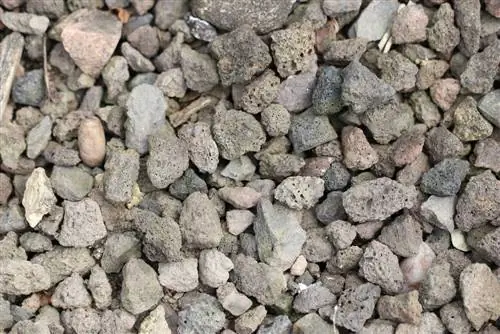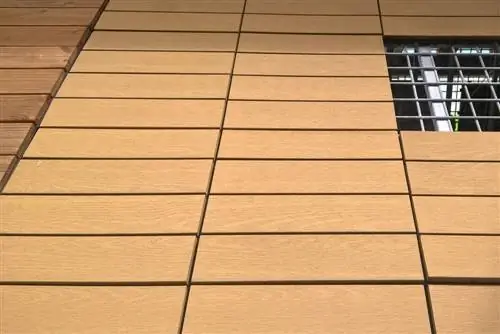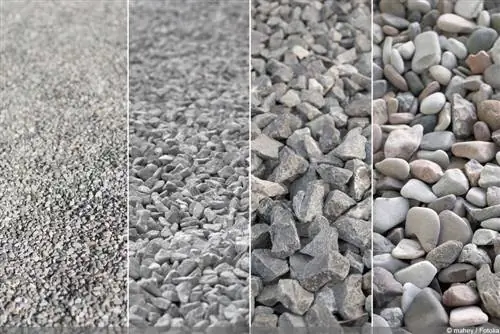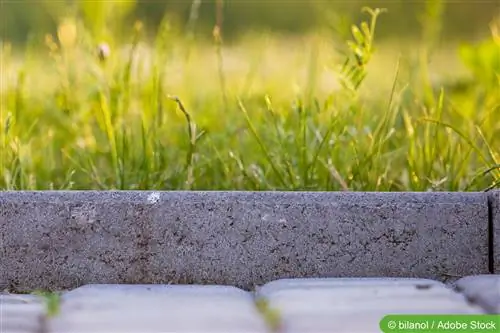- Author admin [email protected].
- Public 2023-12-17 03:39.
- Last modified 2025-01-24 12:45.
If stones are to be laid on a terrace or a garden path, the volcanic rock bas alt is ideal. Bas alt stones are insensitive and very hard and are therefore suitable for areas that are exposed to greater stress. The stones are also easy to process. They can be sanded, polished, brushed, grooved and sawn, so that every garden owner can create their own unique touch on the terrace and paths.
Various bas alt stone sizes and types
Bas alt stones in the garden can be very diverse. Because they come in different sizes. If you want to do a lot of work, use the small dimensions, like those found on cobblestones. If you want to finish building a new terrace or garden path quickly, you can also opt for polygonal panels, which are significantly larger in size. The hobby gardener then has to decide between the different treatment techniques for the bas alt stones, because they are offered commercially as follows:
- ground
- sandblasted
- brushed
- polished
- variants of several of these processes are also available
Tip:
When you go to the hardware store, you shouldn't just pay attention to the appearance of the bas alt stones. Some treatment techniques make the stones slippery, which could become a problem in the garden on the path or terrace, especially when it is wet.
Required materials
If you want to create a path or terrace made of bas alt stones, you will of course need other materials in addition to the stones that have to be processed. Various tools are also required for construction. Before you can begin, the followingMaterials and tools should be purchased or collected:
- enough bas alt stones for the path or terrace
- calculate the number of square meters in advance
- Cement
- Sand
- Gravel or gravel
- Bas alt sand
and asTools
- Spade
- rubber hammer
- Guideline
- Spirit level
- shaker
- a slat to remove
- Concrete mixer, if available, otherwise use a wheelbarrow for mixing
- Shovel for mixing
- Water hose
- Circular saw with diamond disc if the bas alt stones need to be cut
Tip:
If a large patio area and one or more paths are to be laid with bas alt stones, then it is worth renting a concrete mixer from a local hardware store, as in such a case the amount of concrete to be mixed in a wheelbarrow is too much would be a lot of effort.
Getting started
Stake out the desired paths and the terrace size and calculate the total square footage. Only then go to the hardware store and get the desired amount of material and stones. Then proceed as follows:
- excavate the entire soil in the marked area with a spade
- at least 40 cm to ensure frost protection and therefore long durability
- The substructure will go in here later
Tip:
Do not dispose of the excavated topsoil directly but use it for other places in the garden, for example to create new beds or replant pots.
Substructure
Gravel or crushed stone is required for the substructure. Before this is heaped up over the entire area, compact the excavated area well with a vibrating machine. Then proceed as follows:
- Pile up gravel/gravel a hand's width
- distribute well and evenly
- then compact again with the vibrating machine
- This not only compacts the surface of the substructure but also straightens it again
Embedding
Now the cement has to be mixed with sand and water to form a concrete mass. To do this, use the concrete mixer or alternatively the wheelbarrow and a spade or shovel. Once the concrete has the desired consistency, the bed for the bas alt stones is poured:
- Pour about 10 to 20 centimeters of concrete onto the gravel, depending on how high the selected stones are
- there should later be a straight edge between the path or terrace and the surrounding ground
- Always mix and pour only as much concrete as is needed for the next step
- strip with a batten to create a straight surface
- If in doubt, measure with a spirit level
- To do this, carefully place the batten on the concrete and place the spirit level on it
Tip:
Think beforehand about the time required to lay the bas alt stones properly. After that, measure the size that will be poured with concrete. If the concrete becomes hard because work is done too slowly, the stones can no longer be embedded.
Laying bas alt stones
Before the bas alt stones are placed on the fresh concrete, the edge should be measured using a guideline. This way it won't go wrong. Then place the stones one after the other along the guide line and make sure there is an even distance between the individual stones. When installing, also make sure that all bas alt stones are the same height. More concrete is poured into the edge along the stones so that they cannot slip. When laying the stones, the following should be taken into account:
- To create an attractive and consistent pattern, always lay from the outside to the inside
- Tamp laid bas alt stones directly with a rubber mallet
- then fill the joints between the individual stones with plenty of water and bas alt sand
Tip:
When laying the bas alt stones in the garden, ideally work with a spirit level. This means that it can be assumed that the stones were all placed at the same height and that there are no tripping hazards.
Last steps
After the garden path or terrace has been completely laid out with bas alt stones, the area should be carefully swept so that the bas alt sand does not leave unsightly scratches on the new stones. Then work the entire stone surface again with the vibrator. This creates greater strength for the individual stones than could be achieved with a rubber mallet.
Cutting bas alt stones
When laying, it may also be necessary to cut the bas alt stones to the correct size due to the shape or size of the path or terrace. But this isn't a problem either:
- Use a circular saw with a diamond disc for hard material
- When cutting, cool the cut well with water from the garden hose
- When cutting, the interface must not heat up, glow or, in the worst case, even melt
Tip:
When cutting the bas alt stones, the hobby gardener should get a family member to help with water cooling.
Bas alt stones for the garden
Slabs for a terrace or walkway are available in many different dimensions and also as polygonal panels. The surface can also be designed very differently; there are ground, polished, flamed, brushed, sandblasted or bush-hammered panels and also panels that have been treated with several such processes. The thickness of the bas alt slabs also varies; thinner slabs are often only a few millimeters thick, while others are more than a centimeter thick.
Bas alt is also mined in Germany, particularly well-known are the Londorfer bas alt lava, which is mined in Londorf in Hesse, and the Mayener bas alt lava from Rhineland-Palatinate. The Londorfer bas alt lava is gray-black, while the Mayener bas alt lava has a light gray-blue color. As floor coverings, such panels look very elegant both indoors and outdoors. Larger bas alt stones, which are best left untreated, can be used to create a beautiful pond, and thicker paving stones are often used for garden paths or the courtyard. Bas alt stones hardly absorb any water and are therefore frost-proof.
Prices for bas alt stones
Bas alt panels three centimeters thick cost around 50 to 60 euros per square meter. Bas alt chippings can be used in the garden like gravel; a 25 kilogram bag costs around five euros. Bas alt paving stones are priced by weight. They cost between 200 and 400 euros per ton. Depending on the thickness of the paving stones, one ton is enough for an area between three and nine square meters. If you want to save a little, you can also buy used bas alt stones from many suppliers.
Conclusion
Hobby gardeners who have a lot of time and enjoy their work will have no problems designing a terrace or garden path with bas alt stones. Of course, for large areas the work takes several days, as the bas alt stones in the garden are all laid individually and tapped with a rubber mallet. But every hobby gardener who looks at his terrace and garden paths afterwards will be rewarded for his work with the beautiful sight.

